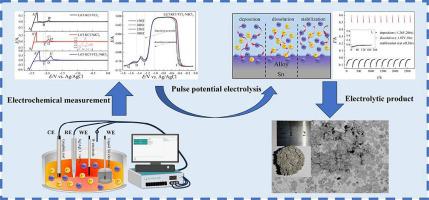当前位置:
X-MOL 学术
›
Sep. Purif. Technol.
›
论文详情
Our official English website, www.x-mol.net, welcomes your feedback! (Note: you will need to create a separate account there.)
Selective separation of Y and Nd with similar electrochemical properties by pulsed electrolysis on Sn electrode
Separation and Purification Technology ( IF 8.6 ) Pub Date : 2024-03-22 , DOI: 10.1016/j.seppur.2024.127200 Ming Gong , Hailing Zhang , Quanzhang Sun , Ji Wang , Shunyan Ning , Xiangbiao Yin , Lifeng Chen , Wenlong Li , Yuezhou Wei
Separation and Purification Technology ( IF 8.6 ) Pub Date : 2024-03-22 , DOI: 10.1016/j.seppur.2024.127200 Ming Gong , Hailing Zhang , Quanzhang Sun , Ji Wang , Shunyan Ning , Xiangbiao Yin , Lifeng Chen , Wenlong Li , Yuezhou Wei

|
Selective separation of Y and Nd from LiCl-KCl melt was systematically investigated on W and Sn electrodes by various electrochemical methods. The electrochemical properties of Y and Nd on W and Sn film electrodes were firstly analyzed and compared by cycle voltammetry (CV), square wave voltammetry (SWV), reverse chronopotentiometry (RCP), etc. The results indicate that the deposition potentials of Y and Nd on W electrode are very close, while the deposition potential difference could reach 0.15 V on Sn film electrode. The selective separation of Y and Nd was conducted by potentiostatic electrolysis (PE) on W electrode assisted by Sn(II), and the product is composed of Sn and NdSn phases. In addition, the electrochemical properties and kinetic parameter of Y and Nd on liquid Sn electrode were also studied. The results prove that Nd has a more positive deposition potential, larger exchange current density and smaller reaction activation energy than Y, illustrating that Nd is more easily extracted on liquid Sn electrode. Thus, PE and potentiostatic electrolysis + pulse potential electrolysis (PE + PPE) were used to separate Y and Nd on liquid Sn electrode. The results show that the application of PPE effectively reduced the extraction efficiency of Y from 16.75 ± 1.50 % to 8.36 ± 1.13 %, and increased the separation factor from 4.98 ± 0.46 to 9.64 ± 0.58.
中文翻译:

Sn电极脉冲电解选择性分离电化学性质相似的Y和Nd
通过各种电化学方法,在 W 和 Sn 电极上系统地研究了 LiCl-KCl 熔体中 Y 和 Nd 的选择性分离。首先采用循环伏安法(CV)、方波伏安法(SWV)、反计时电位法(RCP)等对Y和Nd在W和Sn薄膜电极上的电化学性能进行了分析比较。结果表明,Y和Nd的沉积电位W电极上的Nd非常接近,而Sn膜电极上的沉积电位差可以达到0.15V。在Sn(II)辅助下,通过W电极上的恒电位电解(PE)选择性分离Y和Nd,产物由Sn和NdSn相组成。此外,还研究了Y和Nd在液态Sn电极上的电化学性能和动力学参数。结果证明,Nd比Y具有更正的沉积电位、更大的交换电流密度和更小的反应活化能,说明Nd更容易在液态Sn电极上被萃取。因此,采用PE和恒电位电解+脉冲电位电解(PE+PPE)在液态Sn电极上分离Y和Nd。结果表明,PPE的应用有效地将Y的萃取效率从16.75±1.50%降低到8.36±1.13%,分离因子从4.98±0.46提高到9.64±0.58。
更新日期:2024-03-22
中文翻译:

Sn电极脉冲电解选择性分离电化学性质相似的Y和Nd
通过各种电化学方法,在 W 和 Sn 电极上系统地研究了 LiCl-KCl 熔体中 Y 和 Nd 的选择性分离。首先采用循环伏安法(CV)、方波伏安法(SWV)、反计时电位法(RCP)等对Y和Nd在W和Sn薄膜电极上的电化学性能进行了分析比较。结果表明,Y和Nd的沉积电位W电极上的Nd非常接近,而Sn膜电极上的沉积电位差可以达到0.15V。在Sn(II)辅助下,通过W电极上的恒电位电解(PE)选择性分离Y和Nd,产物由Sn和NdSn相组成。此外,还研究了Y和Nd在液态Sn电极上的电化学性能和动力学参数。结果证明,Nd比Y具有更正的沉积电位、更大的交换电流密度和更小的反应活化能,说明Nd更容易在液态Sn电极上被萃取。因此,采用PE和恒电位电解+脉冲电位电解(PE+PPE)在液态Sn电极上分离Y和Nd。结果表明,PPE的应用有效地将Y的萃取效率从16.75±1.50%降低到8.36±1.13%,分离因子从4.98±0.46提高到9.64±0.58。



























 京公网安备 11010802027423号
京公网安备 11010802027423号